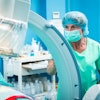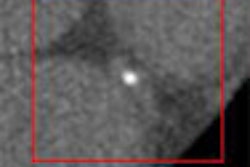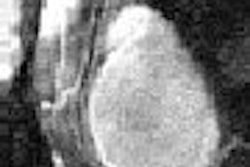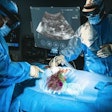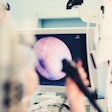Computer-aided detection (CAD) technology may improve the accuracy of radiologists in distinguishing malignant breast masses from benign masses on 3D volumetric ultrasound images, according to research published in the March issue of Radiology.
To retrospectively study the effect of a custom-designed computer classifier on the sensitivity and specificity of radiologists in this application, a research team from the University of Michigan Medical Center in Ann Arbor evaluated 3D volumetric ultrasound images in 101 women with an average age of 51 years. The cohort had 101 biopsy-proven breast masses, 45 of which were benign and 56 of which were malignant (Radiology, March 2007, Vol. 242:3 pp. 716-724).
The researchers acquired the 3D US studies using an experimental system previously developed and tested at their institution, consisting of a commercially available Logiq 700 system (GE Healthcare, Chalfont St. Giles, U.K.), a M12 linear-array transducer, a mechanical transducer-guiding system, and a computer workstation.
The 3D US images were all acquired by the same ultrasound technologist, who had 15 years of breast US experience, using the transducer operating at a frequency of 11 MHz, according to the authors.
Following data acquisition, the US images and position data were transferred digitally to the workstation, where individual planes were cropped and stacked to form a 3D volumetric image, the authors stated.
An algorithm was employed to automatically delineate mass boundaries and extract features on the basis of segmented mass shapes and margins, while a computer classifier was utilized to merge features into a malignancy score. Five experienced radiologists then read cases first without CAD, then immediately afterward with CAD.
Before CAD, the five radiologists had an average area under the ROC curve (Az) of 0.83. The use of CAD, however, increased the average Az significantly (p = 0.006) to an average of 0.90.
When a 2% likelihood of malignancy was used as the threshold for biopsy recommendation, the average sensitivity of radiologists increased from 96% to 98% with CAD, while the average specificity for this data set decreased from 22% to 19%, according to the authors.
"If a biopsy recommendation threshold could be chosen such that sensitivity would be maintained at 96%, specificity would increase to 45% with CAD," the authors wrote.
The study team acknowledged several limitations in the study, including reliance on a dataset that included only masses that were recommended for core-needle biopsy, surgical biopsy, or fine-needle aspiration biopsy. In addition, all studies were obtained on the same US machine; the CAD system should be evaluated with images acquired on other systems, the authors noted.
Also, all of the readers were experienced in interpreting mammograms and US images, so the effects of CAD on less-experienced radiologists was not evaluated, according to the researchers. In addition, the CAD classifier was trained and tested using a leave-one-case-out method, and the segmentation method was optimized using a small subset of the data.
Nonetheless, the researchers concluded that the CAD system led to improvements in the performance of the radiologists.
"A well-trained computer algorithm may improve radiologists' accuracy in distinguishing malignant from benign breast masses on 3D US volumetric images," the authors concluded.
By Erik L. Ridley
AuntMinnie.com staff writer
March 7, 2007
Related Reading
Ultrasound continues to make inroads in breast imaging, February 6, 2007
Automated breast US proves to be sensitive screening tool in dense breasts, November 29, 2006
Streaming US, elastography US give clearer picture of breast lesions, November 16, 2006
3D brings opportunities to sonographers, August 4, 2006
Breast surgeon expresses reservations about screening US, May 13, 2006
Copyright © 2007 AuntMinnie.com



